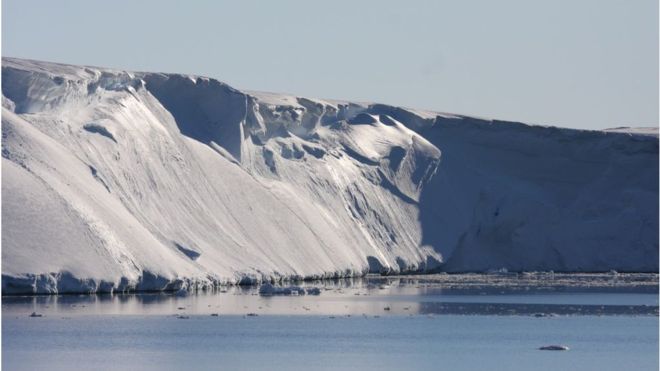
Unchecked climate change could put Antarctica's huge Totten Glacier into an unstable configuration over the coming centuries, a study has warned.
If that happens, the ice loss could push up global oceans by 2m, or more.
The claim is based on an assessment of the rocks underlying the ice stream.
Scientists tell the journal Nature that should the front of the glacier retreat about 150km from its current position, it will then enter a runaway reversal that takes it 200-250km further inland.
Most of the big glaciers in the east of the White Continent appear relatively quiescent; Totten is something of an exception.
It is experiencing a thinning rate of about half a metre per year, according to the latest satellite measurements.
Previous research indicates this is probably being driven by warm ocean water getting under and melting the floating front of the glacier.
Unstable geometry
What Alan Aitken and colleagues have now done is examine a possible future for Totten if the shrinkage continues.
They have used gravity and magnetic data recorded over the entire catchment feeding the glacier to understand its past behaviour.
They find that the underlying sedimentary rocks at the modern front of the glacier are heavily eroded, as are the rocks in fjords deep in the interior of the catchment. The inference is that these sections are where persistent, moving ice has had time to grind down the geology.
It is the mid-region, however, that piques the team's interest. Here, the sediments are relatively thick, suggesting that ice fronts have historically been resident in this section for only short periods.
This mid-region is also where the rock bed dips inland - a geometry that glaciologists say is naturally unstable and accelerates any glacier retreat.
"What this all tells us is that once the ice margin starts to go back, it goes back quite rapidly to a newer, stable position way inland. And if you do that our modelling indicates you will lose ice equivalent to 1.5-2m of sea level rise," co-author Prof Martin Siegert from Imperial College London, UK, told BBC News.
The last time Totten retreated to the deep interior of the France-sized catchment was probably in the Pliocene Epoch, he added.
"Three-point-five million years ago, atmospheric carbon dioxide levels were in the region of 400 parts per million - so about where they are now. The atmosphere was a couple of degrees warmer than it is now, which is in line with what we expect for the end of this century if we do nothing about it. The Pliocene is where we're headed."
Even so, the timescale for the far retreat inland would be on the order of centuries, on current trends.
Sensitivity threshold
The international community has of course committed itself to doing something about climate change, promising at the Paris talks in December to try to keep the global atmospheric temperature rise above pre-industrial levels to "well below 2C".
Various analyses, however, suggest a 2.7C increase is a more likely outcome, based on the voluntary national curbs to greenhouse gas emissions promised at the meeting.
And that variance could be significant, according to research presented at the recent European Geosciences Union meeting in Vienna last month.
Prof Rob DeConto from the University of Massachusetts-Amherst, US, has modelled possible ice losses from the Antarctic continent based on the two temperature figures.
For a 2C rise, he found minimal change by the end of this century. On the other hand, for 2.7C he identified ice losses equivalent to many tens of centimetres of sea-level rise.
"There's threshold behaviour in the Antarctic ice sheet system," Prof DeConto told reporters at EGU.
"We don't know exactly where that line is, but according to these results somewhere between 2C and 2.7C makes a very big difference."

 Previous page
Previous page Back to top
Back to top







